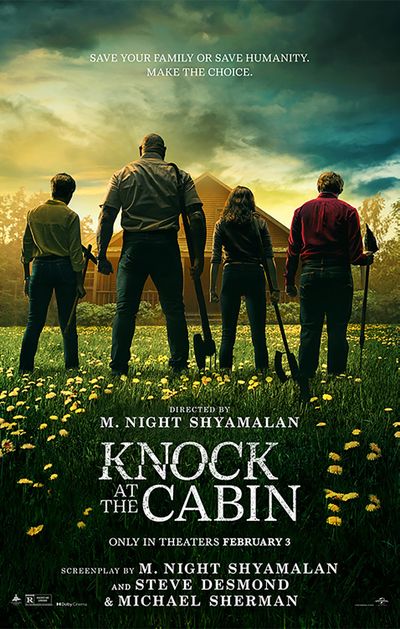Movie Review: M. Night Shyamalan brings signature touch, good and bad, to ‘Knock at the Cabin’

It seems that M. Night Shyamalan has the end of days on his mind. A couple of years ago, he pondered the quandary of aging in “Old,” based on the graphic novel “Sandcastle,” by Pierre Oscar Levy and Frederik Peeters. In his latest film, he turns toward the apocalypse, or at least the idea of it, in “Knock at the Cabin,” adapted from Paul Tremblay’s 2018 horror novel “The Cabin at the End of the World.”
Tremblay’s novel is terrifying in its unpredictability and ambiguity. Structured around a home invasion that takes place over the course of a couple of days, it explores the ways in which a stunning amount of suffering can occur if someone believes enough in their mission, misguided or not. “Knock at the Cabin,” adapted by Shyamalan, Steve Desmond and Michael Sherman, is faithful to the source material until it is not, because this wouldn’t be a Shyamalan movie without his own original take on the ending.
Shyamalan films are always perfectly cast, thanks to longtime casting director Douglas Aibel, who has worked with the director since “Unbreakable” in 2000, and “Knock at the Cabin” is no exception. There are no better actors to play the main trio than Ben Aldridge, Jonathan Groff and Dave Bautista, who tear into these challenging roles with an emotional and technical rigor. The rest of the small cast is uniformly excellent, including the incredible Kristen Cui in her first film role.
Cui plays Wen, the young adopted daughter of Andrew (Aldridge) and Eric (Groff). She’s catching grasshoppers outside their remote lakeside vacation rental when a strange person approaches. Leonard (Bautista) seems to be a gentle giant, but soon he’s intoning scary promises about hard choices that will shortly need to be made. She scurries inside and her dads lock the doors, but the quartet of Leonard, Redmond (Rupert Grint), Sabrina (Nikki Amuka-Bird) and Ardiane (Abby Quinn), make their way in nevertheless, with brute force and odd weapons, in order to present the family with a choice: sacrifice one of their own, or watch the apocalypse unfold.
It’s a straightforward if extreme concept, and the majority of the film takes place inside the walls of this vacation rental, unfolding almost like a play. There are detours into Eric and Andrew’s flashbacks, and TV news reports that seemingly underline Leonard’s warnings, but the power of this story is that it takes place entirely among this group of seven – four of them trying to convince the other three that if they choose one to kill, they can save the world. The persuasive tactics the four strangers employ are violent, and bloody, and often directed at each other.
Shyamalan likes to get creative with unique framing choices, and working with cinematographers Jarin Blaschke (Robert Eggers’ collaborator on “The Northman,” “The Lighthouse” and “The Witch”) and Lowell A. Meyer, he works to cinematically activate the space inside and around the cabin, alternating fluid dolly shots with steady, locked-off compositions that speak to the shifting alliances within. The opening sequence between Wen and Leonard is shot and edited to show these characters coming together and the world tilting on its axis as the conversation turns toward the ominous. Later, the camera will frame Andrew and Eric together, then apart, shifting from one side of the frame to the other as Leonard and his gang drive a wedge between them.
The characters often speak directly into the camera in centered close-ups, calling to mind that classic fourth-wall breaking moment in Alfred Hitchcock’s “The Birds” when Tippi Hedren accuses the audience as being the responsible parties for her torment. Rather than confront us, Shyamalan seems to be posing the central question to us too – what would we believe?
What’s most fascinating about the request Leonard makes is the request itself, and the way in which the things that we choose to believe, and the things of which we can be convinced are so deeply personal. Whether or not the apocalypse is actually happening is not the interesting part of this story of humanity, love and destruction. In his book, Tremblay hit on something that would become worryingly relevant in the past few years – the phenomena of collective mass delusions that can cohere online, usually revolving around doomsday scenarios. It’s the delusions that are horrifying here, not the doomsday. Tremblay knows that, but it seems that Shyamalan and his co-writers don’t subscribe to that notion, and their tweaks to this story, despite the impeccable cinematic craft and tremendous acting on display, hobble the adaptation’s power.